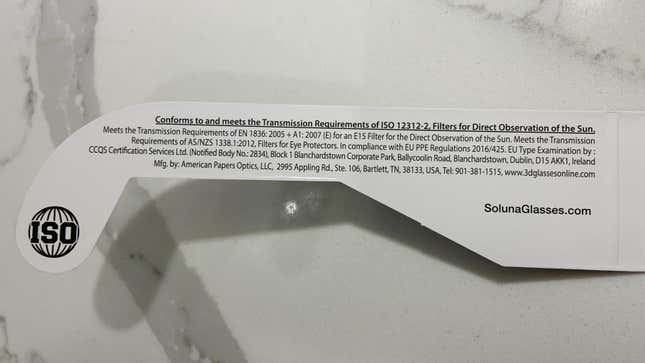During the total solar eclipse on April 8, millions of people across North America will stare directly into the Sun—hopefully through eclipse glasses or hand-held viewers. Sadly, fakes are entering into the market, but there are steps you can take to make sure you’ve got the real deal.
The Sun, it goes without saying, is a very bright object. During the eclipse, it’s not so bright, as the Moon slowly moves across its face. It suddenly becomes comfortable to gaze directly into our host star, but it’s this comfort that makes eclipses so dangerous.
No alternatives
When viewing a solar eclipse, it’s crucial to use proper protective eyewear due to the potential damage caused by overexposure to the Sun’s ultraviolet, visible, and infrared light. Alternatives, such as regular sunglasses or welders masks, aren’t good enough. Failing to use eclipse glasses, or using fraudulent glasses, can lead to irreparable visual damage—a condition known as solar retinopathy.
Related article: Here’s Exactly What Will Happen to Your Eyes If You Stare at the Eclipse Without Protection
Solar filters need to be powerful, blocking between 1 in 100,000 to 1 in 2 million parts of visible light, according to the American Astronomical Society. Rick Fienberg of the AAS Solar Eclipse Task Force notes that these filters are over a thousand times darker than the darkest regular sunglasses. To ensure safety, glasses must meet the ISO 12312-2 standard, visibly marked on the glasses themselves.
Making a smart purchasing decision
Sadly, the AAS is warning of fakes, saying it has uncovered evidence of bogus eclipse glasses entering the market. Counterfeits and fakes are scary, but by making smart purchasing decisions, and then testing the units yourself, you can confidently and safely observe the solar eclipse.
The first step is to purchase the units directly from a reputable, vetted vendor. The AAS has put together a list of vetted vendors, which you can access here, and includes such names as B&H Photo & Video, Walmart, and Staples, among many others. The list also includes approved manufacturers, including American Paper Optics and Halo Eclipse Spectacles. The AAS warns against buying eclipse glasses and viewers from random sellers in online marketplaces, even if they claim their products come from AAS- or NASA-approved suppliers.
Now, in the event you already got your eclipse glasses or hand-held viewers from a non-approved vendor, that’s okay. There are steps you can take to verify their authenticity—steps that are advisable regardless of the vendor. This actually describes my situation; I bought some eclipse glasses off Amazon, specifically the ones from Soluna, and they passed the sniff test I’m about to describe.
Inspecting and testing
Once you get the units, it’s a good idea to check the lenses for defects, such as scratches, holes, or slits. Also, check to make sure the ISO 12312-2 standard appears directly on the unit.

Assuming everything looks good, put them on while indoors and have a look around. You should see absolutely nothing, except for bright lights, which should appear faint. But if you’re seeing furniture, the clock on the wall, or your cat, that’s bad, and a sign that you have a fake.
The next step is to go outside and look around. Again, you shouldn’t see anything except, perhaps, the reflection of the Sun off a window. Take a look at the Sun, but only for one second. The filtered view should show a perfect circle, resembling the Moon in shape and size. Depending on the filter used, this circle may appear in different hues, such as yellow, white, bluish-white, or orange.
Smart, conservative viewing
If your eclipse glasses or viewer satisfy all these requirements, it means you’re good to go. “But if you aren’t completely confident of the safety of your eclipse glasses, you should use them sparingly,” the AAS advises. During the eclipse, “look at the Sun through the glasses for no more than 2 or 3 seconds every 5 minutes or so. This will be enough to observe the Moon covering more and more of the Sun before maximum eclipse, then uncovering more and more of it after maximum eclipse.”
Makes sense to me, and that’s how I plan to view the total solar eclipse when the day finally arrives. It’s important to keep in mind that the eclipse experience, from start to finish, can last for nearly three hours.
Soluna, the manufacturer of the glasses I procured, provides its own list of guidelines directly on the glasses:
Inspect each time before use. Do not use…if damaged, torn, punctured or separated from the frame in any way. Do not use with other optical devices. This is not a toy. Children should only use with adult supervision. Limited to 3 minutes continuous use, intermittently for several hours. When using this product do not move around, drive a motor vehicle, or operate machinery. Do not use with diseased eye or after eye surgery.
Again, smart advice. The common thread is that you should gaze at the Sun sparingly, and don’t overdo it. For those of you planning to view the eclipse from within the path of totality, we have a guide to help you get the most out of the experience. So enjoy, and here’s hoping for clear skies!

